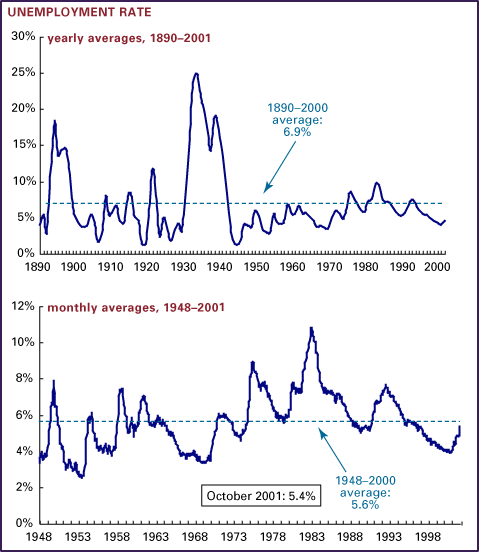
Home Mail Articles Stats/current Supplements Subscriptions Links
an LBO overview
last update: November 9, 2001
Unemployment is a very relative concept. Under current U.S. definitions, you have to be actively looking for work to count as unemployed; if you've given up the search for work as hopeless, you don't count as jobless. One reason for this may be that the statistics are collected with employers in mind, and employers care only about the degree of slack in the labor market - that is, they like just enough to keep workers a bit scared, but not so much as to threaten economic and political stability. Workers only marginally attached to the labor force don't enter into this calculation.
This is what the mainstream debate over the statistical level of "full employment" is really about; orthodox economists disagree over the precise numerical level - 5%? 5.5%? 6%? 6.5% - but not the fundamental principle. If the unemployment rate gets too low, wages will rise - this is what's behind the euphemism "inflation" and all the anxieties about it.

Unemployment has risen sharply in recent months, and it's likely to risse further. It's not near the level of earlier recessions - right now it's still below long-term averages - but the trend is not good, and the working class is almost always better off when the rate is falling than when it's rising. The official rate is up 1.5 percentage points from its low, as is the broad rate. The black rate is up almost twice as much.
What about prisoners? If all adults behind bars were included, and all assumed to be unemployed, the unemployment rate would be about a point higher. That for black men would rise stunningly, to near 20%.
Official definitions of joblessness understate things, of course. The indicator, remember, is collected for employers who want to know how tight labor markets are; they're not looking for a measure of deprivation. People who work one hour during the week of the survey are counted as employed; those who've given up the job search as hopeless aren't counted as unemployed; African-Americans and Latinos are far more unemployed than whites.
jobless detail
unemployment by group, November 2001
all 5.4% men (>20) 4.8 women (>20) 4.8 white 4.8 black 9.7 black teens 30.1 Hispanics 7.2 no diploma 7.7 HS grads 4.7 some college 4.1 college grad 2.7 broad* 8.7 * The broad unemployment rate includes those employed part-time for economic reasons (those who want full-time work but can only find part-time) and "marginally attached" workers (those who want to work but who have given up the search as hopeless). It's not adjusted for seasonal variation, so it can be volatile.
Sources: Historical Statistics of the United States, Colonial Times to 1970; National Bureau of Economic Research; U.S. Bureau of Labor Statistics. Real wage is the nominal wage divided by the consumer price index.
Home Mail Articles Stats/current Supplements Subscriptions Links